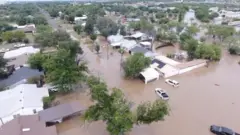Texas Flash Floods: Examining the Early Warning System and Preparedness
Central Texas is reeling from devastating flash floods that have claimed the lives of nearly 80 people, with officials warning that the toll is likely to rise. The rapid and intense flooding, which saw the Guadalupe River rise by an astonishing 26 feet in just 45 minutes, has raised critical questions about the adequacy of early warning systems and the effectiveness of evacuation procedures.
Kerr County has been the hardest hit, accounting for a significant number of the fatalities, including 28 children. The overwhelming surge of water inundated areas, including a girls’ camp, leading to a tragic loss of life. Judge Rob Kelly, the chief elected official in Kerr County, stated that the scale of the disaster was “unexpected,” with no prior indication of the catastrophic potential of the rainfall.
What Flood Warnings Were Issued?
The timeline of warnings leading up to the disaster indicates a series of alerts issued by state and federal agencies. The Texas Division of Emergency Management (TDEM) had activated state emergency response resources on Wednesday, recognizing an increased threat of flooding in West and Central Texas. By Thursday afternoon, the National Weather Service (NWS) issued a Flood Watch, specifically identifying Kerr County as a high-risk area for overnight flash flooding.
Crucially, a flash flood warning was issued for Kerr County at 01:14 local time on Friday. This was followed by an emergency flash flood warning for the same county at 04:03 local time, with another alert for the Guadalupe River issued shortly after at 05:34. Despite these warnings, the sheer speed and intensity of the flooding appear to have overwhelmed local preparedness measures.
Examining Preparedness and Communication
In the aftermath, questions have surfaced regarding the effectiveness of government preparedness and communication strategies. Governor Greg Abbott remarked that Texans are accustomed to flood warnings but acknowledged that “there’s no expectation of a water wall of almost 30ft high.”
Nim Kidd, chief of the Texas Division of Emergency Management, highlighted challenges such as inconsistent cellular coverage, which could hinder the reception of alerts. Dalton Rice, Kerrville City Manager, noted that while the town’s river trail was experiencing only light rain at 03:30 on Friday, the water levels rose so rapidly that by 05:20, evacuation from the park became perilous.
Judge Kelly also pointed out that the county had previously considered implementing a flood warning system, similar to a tornado siren, approximately six years prior. However, due to the significant cost associated with such a system, it was never implemented. This decision has now come under scrutiny in light of the tragic events.
The NWS defended its actions, stating that its Austin/San Antonio office provided forecast briefings to emergency management on the morning of July 3 and issued a Flood Watch in the early afternoon. They maintained that Flash Flood Warnings were issued on the night of July 3 and the early morning of July 4, providing over three hours’ lead time before warning criteria were met. Some experts, speaking to The New York Times, suggested that the forecasts were as accurate as possible given the extreme rainfall and the storm’s rapid escalation, pushing back against claims that the NWS underestimated the event.
Staffing and Budgetary Concerns
Discussions have also touched upon the potential impact of budget cuts on the National Weather Service (NWS) and its parent agency, the National Oceanic and Atmospheric Administration (NOAA). Concerns were raised about budget proposals that included cuts to weather research laboratories and significant staff reductions at NOAA and the NWS. Meteorologists have voiced apprehension that a reduction in weather balloon releases for atmospheric observations could affect forecasting accuracy.
The New York Times reported on potentially vacant critical positions within the NWS, leading to questions about whether staffing shortages impacted the agency’s coordination with local emergency managers. However, Tom Fahy, legislative director of the NWS Employees Organization, stated that the weather forecasting offices (WFOs) were adequately staffed and resourced to issue timely warnings. Conversely, Jason Runyen, an NWS meteorologist, noted that the office responsible for the affected region had five staff members on duty during the storms, exceeding the usual two.
Government Response and Future Preparedness
When questioned about whether the tragedy stemmed from a “fundamental failure” in providing early warnings, US Homeland Security Secretary Kristi Noem acknowledged the difficulty in predicting weather patterns but emphasized President Trump’s commitment to modernizing the existing system. She pledged to relay concerns about NWS budget cuts back to the federal government, stating that while the NWS has historically performed well, there is a universal desire for enhanced warning times.
Secretary Noem highlighted the administration’s priority to upgrade NWS technology, which she described as having been neglected. She indicated that President Trump is focused on rectifying these technological deficiencies, with ongoing reforms aimed at improving warning systems. President Trump is reportedly planning a visit to the affected area.

